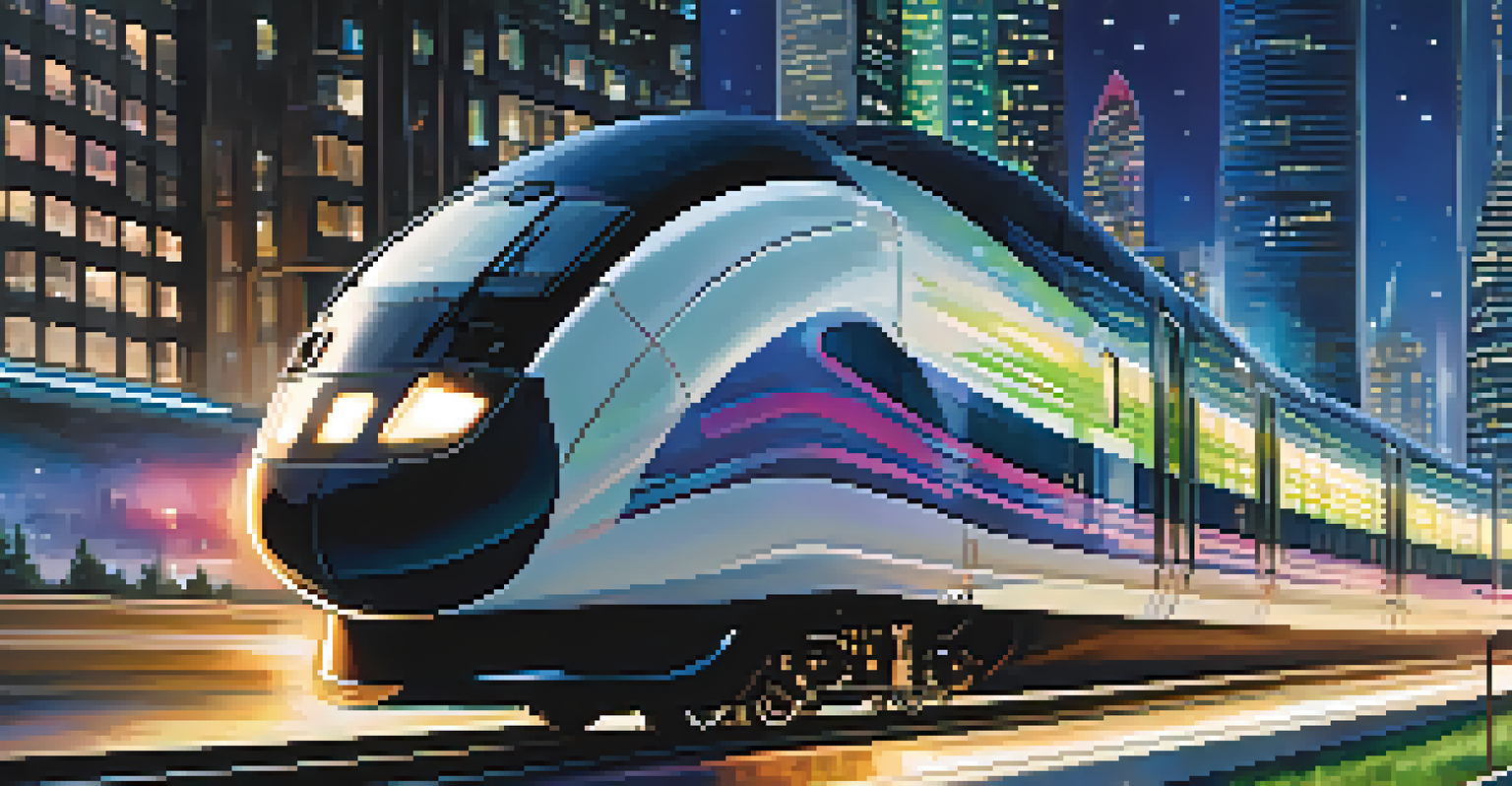The History of Train Travel: A Journey Through Time

The Birth of Railroads: A Revolutionary Innovation
The history of train travel begins in the early 19th century, a time when the world was on the brink of industrialization. The first steam locomotive, built by George Stephenson in 1814, marked a significant turning point, paving the way for rail travel as we know it today. This innovation was not just about speed; it transformed societies and economies by connecting distant regions.
The train is a small world moving through a larger world.
Before the steam locomotive, horse-drawn railways existed, but they were limited and not very efficient. The introduction of steam power changed everything, allowing trains to carry heavier loads at much greater distances. This shift fueled the growth of industries and allowed goods to move faster, significantly boosting trade.
As rail networks expanded, so did the idea of travel itself. The ability to journey across vast landscapes in a fraction of the time previously required opened up new horizons for people. The railroad became a symbol of progress and modernity, capturing the imagination of a generation eager for adventure.
The Golden Age of Rail Travel: Luxury and Adventure
By the late 19th and early 20th centuries, train travel entered its golden age, characterized by luxury and opulence. Famous trains like the Orient Express offered not just transportation but an experience filled with fine dining and plush accommodations. Travelers dressed in their best, eager to enjoy the journey as much as the destination.

This era also saw the expansion of railway networks across continents, making train travel a popular choice for adventurers. The scenic routes through mountains, valleys, and along coastlines provided breathtaking views that only added to the allure of rail travel. People began to see trains as a way to explore the world, fostering a sense of wanderlust.
Railroads Transformed Society
The introduction of steam locomotives revolutionized transportation, connecting distant regions and boosting trade.
However, it wasn’t just about leisure travel; railroads were essential in shaping economies and societies. They facilitated the movement of people and goods, connecting rural areas with urban centers, and enabling the rise of cities. This interconnectedness played a crucial role in the socio-economic development of nations.
The Impact of Technology: Modernizing Train Travel
As technology advanced, so did the rail industry. The introduction of electric and diesel trains in the mid-20th century revolutionized the way we think about train travel. These innovations not only improved efficiency but also reduced travel times significantly, making trains a more practical option for everyday commuters.
Trains are a reminder that life is a journey, not a destination.
High-speed trains, like Japan's Shinkansen, emerged as a game-changer, offering speeds that rivaled air travel. These trains transformed the perception of distance, allowing people to easily travel between cities that were once hours apart. The convenience and speed of modern trains have made them an appealing choice for many.
Moreover, advancements in safety and comfort have made train travel more enjoyable. Features like spacious seating, onboard Wi-Fi, and dining options have enhanced the passenger experience. As a result, train travel has become increasingly popular, not just for leisure but also for business travel.
Environmental Considerations: The Green Choice
In recent years, train travel has gained attention for its environmental benefits. As concerns about climate change grow, trains are being recognized as a more sustainable mode of transportation compared to cars and planes. They produce lower carbon emissions per passenger, making them a greener choice for travelers.
Many countries are investing in modernizing their rail infrastructure to promote train travel as an eco-friendly alternative. Initiatives include electrifying train lines and implementing energy-efficient technologies. This shift not only helps reduce environmental impact but also encourages more people to choose trains for their journeys.
Modern Trains are Eco-Friendly
Train travel is increasingly recognized as a sustainable transportation option, producing lower carbon emissions compared to cars and planes.
Furthermore, the focus on sustainability has sparked interest in new technologies like hydrogen-powered trains. These innovations promise to further decrease the carbon footprint of rail travel, aligning with global efforts to combat climate change. The future of train travel looks promising, with a strong emphasis on environmental stewardship.
Cultural Significance: Trains in Literature and Film
Trains have long held a special place in culture, featuring prominently in literature, films, and art. From Agatha Christie's 'Murder on the Orient Express' to the iconic scenes in 'Harry Potter,' trains are often used as symbols of adventure, mystery, and nostalgia. They evoke a sense of romance that resonates with audiences across generations.
Moreover, the experience of train travel often becomes a character in its own right, influencing the storyline and the emotional journey of characters. The rhythmic sound of wheels on tracks and the changing scenery create a unique backdrop for stories, allowing for profound moments of reflection and connection.
This cultural significance has helped maintain the allure of train travel, encouraging people to embark on journeys that are as much about the experience as they are about reaching a destination. Trains continue to inspire creativity and capture the imagination of storytellers worldwide.
Challenges Facing Modern Rail Systems
Despite the many advantages of train travel, modern rail systems face a range of challenges. Aging infrastructure, funding shortages, and competition from other modes of transport pose significant hurdles. Many rail networks require substantial investment to upgrade tracks and trains, which can be a complicated and lengthy process.
Additionally, the rise of budget airlines has made air travel more accessible, drawing passengers away from trains. While trains offer unique advantages, such as comfort and scenic views, they must compete with the convenience and speed of flying, especially for long distances. This competition necessitates innovation and improvement within the rail industry.
Challenges for Rail Travel Persist
Modern rail systems face significant challenges, including aging infrastructure and competition from budget airlines, necessitating innovation and investment.
To address these challenges, many rail companies are focusing on enhancing the overall experience for passengers. This includes modernizing facilities, improving punctuality, and offering competitive pricing. By adapting to the changing landscape, trains can continue to be a viable and attractive option for travelers.
The Future of Train Travel: Innovations Ahead
Looking forward, the future of train travel is bright, with numerous innovations on the horizon. Concepts like autonomous trains and hyperloop technology promise to redefine the speed and efficiency of rail travel. These advancements could significantly reduce travel times, making trains an even more appealing choice for commuters and travelers alike.
Sustainability remains a core focus for the future of rail systems, with ongoing research into renewable energy sources and eco-friendly technologies. As countries strive to meet climate goals, investments in green rail solutions could reshape the landscape of transportation, aligning with global sustainability efforts.

Moreover, the integration of digital technologies, like mobile ticketing and real-time tracking, is set to enhance the passenger experience. As train travel continues to evolve, it will likely retain its charm while embracing modern conveniences, ensuring it remains a beloved mode of transport for generations to come.